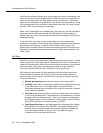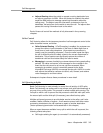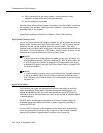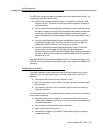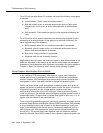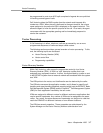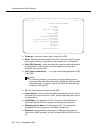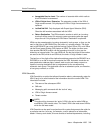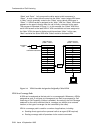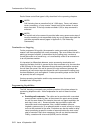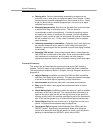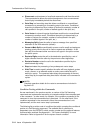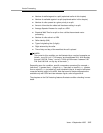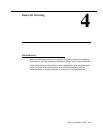
Vector Processing
Issue 4 September 1995
3-9
■ Acceptable Service Level. The number of seconds within which calls to
this VDN should be answered.
■ VDN of Origin Annc. Extension. The extension number of the VDN of
Origin announcement. Only displayed if VDN of Origin Announcement is
optioned.
■ 1st/2nd/3rd Skill. Only displayed with Expert Agent Selection (EAS).
Gives the skill numbers associated with the VDN.
■ Return Destination. The VDN extension number to which an incoming
trunk call will be routed if it returns to vector processing after the agent
drops the call. Only displayed if VDN Return Destination is optioned.
VDNs can be preassigned to incoming (automatic) trunk groups, or they can be
sent in digit form to the PBX/ACD by the public or a private network. The digits
sent to the PBX/ACD can come from the serving Central Office (CO) or toll office
via the Direct Inward Dialing (DID) feature or DNIS. The digits can also come
from another PBX/ACD location via dial-repeating tie trunks, or they can be
dialed by an internal caller. For a non-ISDN call, the last four digits of the number
are sent to the PBX, while for an ISDN call, the entire 10-digit number is sent.
The last four or five digits of the destination address passed to the PBX/ACD on a
DID/DNIS or on a dial tie-trunk call comprise the VDN. Automatic trunks do not
pass destination address digits. Instead, each such trunk always routes to a
specific incoming destination that is programmed for the corresponding
automatic trunk group. The destination can be an attendant queue, an extension,
a hunt group number, or a VDN.
VDN Override
VDN Override is an option that allows information about a subsequently routed to
VDN (if any) to be used instead of the information about the current VDN. This
information includes:
■ The name of the subsequent VDN
■ Skill sets
■ Messaging split command with the “active” entry
■ VDN of Origin Announcement
■ Tenant number
NOTE:
Throughout this document the “active” VDN is the active called VDN as
modified by VDN override rules. The “latest” VDN is the most recent VDN to
which the call was routed.
VDN Override can be used in conjunction with a vector that prompts the caller for
a particular service. Let’s say, for example, a call is placed to an automobile
dealer. Like any such dealer, this one consists of several departments, including




